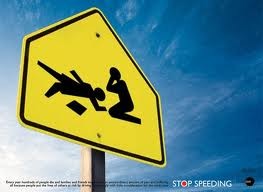Stats Show Stop Signs Save Lives - Along with Other Methods of Traffic Calming
“In almost all U.S. cities, the bulk of the right-of-way is given to the roadway for vehicles, the least to the sidewalk for pedestrians… just suppose that Americans were to extend their walking radius by only a few hundred feet. The result could be an emancipation… –William H. Whyte (CITY: Rediscovering the Center)
In Caldwell, an issue arose recently when a group of people actually protested the erection of stop signs near an elementary school and a park. Though the facts, reinforced by federal, state and local safety officials including the department of transportation show otherwise, some residents have been complaining that erecting stop signs on side streets - though heavily traveled - are slowing them down too much.
The stop signs, they said, were a "nuisance". They "slow down traffic" and entice drivers to take different streets to get where they are going. (All quotes from actual anti-stop sign residents.)
On a recent blog, one poster wrote: "The Stop Sign placement was outright RUDE. Their placement defied logic and further, the exact Engineering guidelines governing such placements. A 25 MPH residential zone is more than adequate governance enough for me to trespass through safely without disturbing your backyard barbeque." (mispelling intentionlly kept in).
So - here is the 2012 question: when is it rude to protect children walking to school? Is a posted 25 MPH speed limit enough to slow down traffic - or, has the alarming growth of pedestrian and vehicle accidents, some fatal as in Caldwell last year when crossing guard Bill Payne was struck and killed while on duty crossing kids, enough?
What really is the truth about these stop signs and how they influence the speed of vehicles? in 2011, a total of 144 pedestrians died, and 635 died due to vehicle accidents. The highest death toll for pedestrians was in Essex County.
There are many methods to calm traffic. Stop signs are just one of these methods. Here is a short list of other proven methods to slow down traffic:
Diagonal Parking
Changing One-Way Streets to Two-Way
Widening Sidewalks/Narrowing Streets and Traffic Lanes
Bulbs – Chokers – Neckdowns
Chicanes
Roundabouts
Traffic Circles
Raised Medians
Tight Corner Curbs
Diverters
Road Humps, Speed Tables, and Cushions
Rumble Strips and Other Surface Treatments
What is more important: convenience and speed on our local roads, close to the paths of young schoolchildren, or safety?
What about the facts?
FROM DIRECT GOV:
The risk of death is approximately four times higher when a pedestrian is hit at 40mph than at 30mph.
The difference of a few miles per hour can mean the difference between life and death. The faster someone is driving, the less time they have to stop if something unexpected happens.
If you kill someone while speeding, you will have to live with the long-term emotional consequences.
Speed limits are there for a reason.
The facts:
Speed is one of the main factors in fatal road accidents
In 2009, 4,187 people were killed or seriously injured in crashes where speed was a factor
The risk of death is approximately four times higher when a pedestrian is hit at 40mph than at 30mph
The law
Fatal accidents are four times as likely on rural roads as urban roads.
FROM PARKINGSIGNCORNER.ORG: PEDESTRIAN SIGNS
According to the National Highway Traffic Association and Insurance Institute for Highway Safety:
Over 180,000 pedestrians have been killed in motor vehicle accidents between 1975 and 2005.
On average, a pedestrian is killed in a traffic accident every 111 minutes.
Pedestrians comprise the second largest category of motor vehicle accident deaths.
On average, a pedestrian is injured in traffic every 8 minutes.
When struck by a vehicle, a pedestrian is at risk for countless serious injuries.
Source

